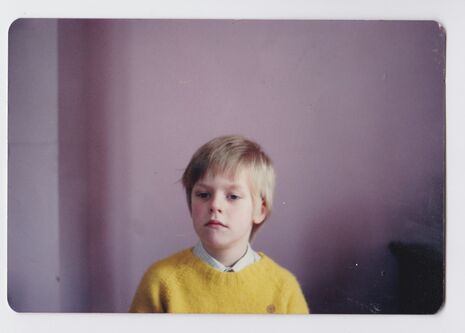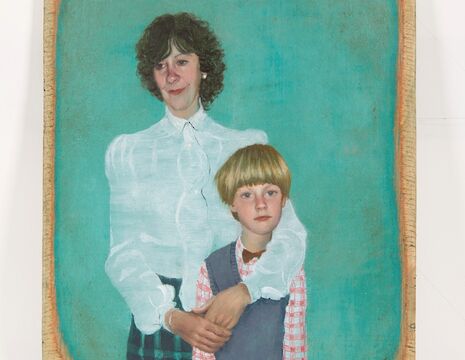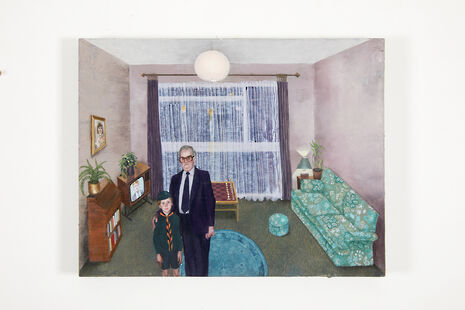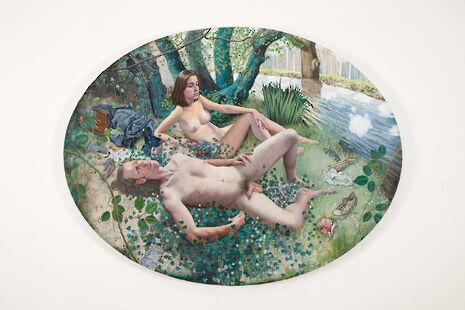HALFBOY: an interview with artist Stuart Pearson Wright
Nick Collin speaks with the celebrated portrait artist on his new exhibition on childhood and family at the Heong gallery

As a young artist, Wright was described as the ‘Hogarth of our times’ - now with 20 years of celebrity-studded commissions including John Hurt, JK Rowling, and a nude Diane Abbott, HALFBOY, his latest exhibition, is an emotionally intelligent investigation into his own childhood and relationship with an absent father. Upon arriving at the gallery, I found Wright drilling in the last few screws to hang the still-wet ‘Boy with a bleeding head’. Tall and bespectacled, the artist commanded the gallery space with his words as well as his limbs, stretching meters-wide measuring-tape whilst calling out for numbers and answers from curator Dr Prerona Prasad. Surrounding him are a series of paintings that capture the muted expressions from mandatory school portraits and family gatherings, the awkward postures and empty eyes of children entirely uninterested in being photographed. He cheerfully bounded towards me to say ‘Hi’.
"Instead of trying to deny the theatricality of portraiture, I grasp that."
Born in 1975 in South London, Wright uses this exhibition to confront the difficult truth that he will never be able to know the identity of his father, an anonymous sperm donor. He begins the exhibition with several images of him as a young boy: alone in his childhood home around a council estate in Buckinghamshire, or amongst half-brothers and sisters in the “drab” domestic scenes of 1970s Britain. These transition to Wright as a teenager and a young man navigating a new set of domestic relationships, and ultimately as a father himself. Wright’s paintings exude a sullen personality, with drab backdrops framing Freud-like contorted faces glaring at the viewer. The exhibition does not become overly-serious for this however, often winkingly gesturing to the retired relics of the 1970s: the baggy suits, box TVs, and heavy-set glasses. Compositionally, Wrights thoughtful staging of group portraits and characteristic “half-realist” approach to perspective produce a fascinating dynamic between the characters depicted, fully realising the potential of the “theatricality of portraiture”. After a quick break for a burrito and a root beer, Wright was happy to talk with me about the exhibition.

Like many other artists, Wright found an “intuition, a facility” for drawing and painting at a very young age. “I still remember very clearly a painting I did of my stepdad at about 7 or 8 - what I remember very clearly of it were these things about my stepdad that I picked up on, you know, the way he sat, the way he held his fingers together in a certain way - the fetal processes that would lead to me eventually painting portraits. I was looking for these details, this character.” Wrights attention to this character is felt when viewing one of his arresting portraits: the richness of personality is clear. Talking on his own process, however, Wright says: “I’ll tell you what I don't do, I'm not trying to capture a person’s soul, and all those clichés. It really is a question of looking at a person as an object, and they are an object when you are drawing them, crucially - they might not think they're an object but when they are being drawn a person becomes an object: they're composed of abstract elements - form, shape, tone - all those things are illuminated by light which cast shadows, and collectively this reveals the form in front of you. Look at this way: the drawing is a 2-dimensional object, and the object is 3-dimensional, so whatever I'm doing there's some level of fake. It's a piece of theatre.
“Instead of trying to deny the theatricality of portraiture, I grasp that. It's inauthentic to present this as a kind of fact, when it's just pigment on paper. I suppose there's something Brechtian in my work - so I'll piss around with perspective, I'll tilt things up. I present something as a sort of stage-production: kind of like a raked stage. But I'll do this within the language of realism, so you get this kind of play - the feel of real and not-real. I don't want to abandon the language of naturalism, because there is something in naturalism that really pulls the eye in, it's attractive. So I'll play this game with the viewer where I'll pull them in and push them away, so they don't quite know where to stand.”
"For the first 9 years of my life I was moving around a lot, so I have quite an odd relationship with place, and memory."
Describing his own childhood as ‘nomadic’, Wright was moving around the greater London area sometimes several times a year as a child. Looking at the handful of paintings that depict the suburban sprawls iconic of the 1970s, there seems to be notes of nostalgia in how Wright handled them despite the definite wasteland feel – in the corner of one painting we see a dead tree lingering, O’keeffe style, before an infinite horizon. I asked him how he felt now about that environment: “[Those paintings were set] in the same house in Buckinghamshire on this circular council estate – Typical two-up two-down council housing with these little twee gardens. These people on that street looked after these tiny little gardens, and so I suppose there is this weird fondness towards the place and how it looks - something endearing about that. But also, an inherent hatred of that architecture, of that drab 70's council estate architecture… I don’t like any of it!”

There is no explaining this exhibition without an awareness of Wright’s unusual conception. As one of the first children born in the UK by artificial insemination from an anonymous sperm donor, Wright spoke sincerely about the loneliness and confusion he felt as a boy growing up without the father figure. Indeed, this absence has become more pointed for Wright in recent years given he has become a father. However, Wright is also interested in exploring his “slightly ambivalent relationship” with his stepdad. “When he died I was a student at art school at the time, at Slade, and I had a sense I'd want to paint him someday. So I actually produced a death-mask of him on that basis - I found myself smearing Vaseline into my stepdads dead eyebrows.
“I was just in this morgue in Eastbourne, just putting this stuff on, you know, putting my apron on and I was fine, doing this and then took this mask off and cleaned up, and then I just melted, I collapsed on the floor. This delayed grief reaction, it was very strange. Coming back to this ambivalent relationship with him then, I wanted to think about that, address it, and think about the word stepdad, because I wasn't allowed to use it.”
The exhibition grows with Wright – there is a “loose chronology” that takes us from him as an eight-year-old to him as a parent, with a brief look into his teens and mid-twenties along the way. When asked about the transition, Wright points out that this was just the “tip of the iceberg”: he began with something like 30 or 40 ideas for the collection but found himself pushed for time. Full-bearded and with a short haircut, Wright found some problems trying to depict a rather specific memory in ‘Up the Downs: a teenage tragedy of erotic ineptitude’ – a self-portrait with an old, rather disappointed lover – “I had to do a sort of 'Frankenstein’s monster' effect to some of my own facial features on the life model, a strange stitching together.” Nevertheless, the results are deeply striking, both for its stark nudity and other-worldly woodland setting.

A somewhat tangential theme of the exhibition is Wright’s exploration of his relationship with this natural world. Whilst he confesses that he has always rather struggled with landscapes (“I was repainting the grass 5 times over!”), he employs natural elements in varied ways – from the tidied box of grass that exaggerates the little boys’ isolation in ‘The loneliest boy in the whole fucking world’, to the greyed forests playing up the uncertainty of the figure in a painting like ‘Wanderer’. This tangential theme is provocative, though it does draw away from the impact of the central visual themes around the suburbs and the family home – the exhibition loses what could have been a tight cohesion as a result.
Despite the somewhat scattered theming, the exhibition is excellent. There is a deeply sensitive treatment of Wrights own unique childhood experience and relationships, and his unique ‘naturalistic’ style, together with a powerful eye for character composition, result in a collection of paintings that will fix upon any viewer that wanders through Downing’s Heong gallery.
 News / Caius mourns its tree-mendous loss23 December 2025
News / Caius mourns its tree-mendous loss23 December 2025 News / Clare Hall spent over £500k opposing busway 24 December 2025
News / Clare Hall spent over £500k opposing busway 24 December 2025 Comment / Yes, I’m brown – but I have more important things to say22 December 2025
Comment / Yes, I’m brown – but I have more important things to say22 December 2025 Interviews / Politics, your own way: Tilly Middlehurst on speaking out21 December 2025
Interviews / Politics, your own way: Tilly Middlehurst on speaking out21 December 2025 Comment / The ‘class’ of Cambridge24 December 2025
Comment / The ‘class’ of Cambridge24 December 2025








